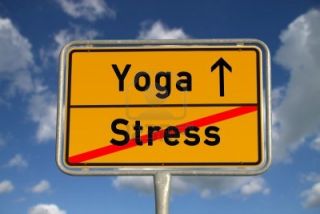Stress
Stress Busters: Yoga and Exercise!
Stay Fit and Healthy Even as Summer Fades
Posted August 30, 2012
With summer drawing to a close, most of us are in pretty good shape. Running around outdoors burns off calories and naturally reduces our appetite. Now, the stress is about to start. The kids go back to school, work starts up again, the schedule gets tighter…and much more.
I invited Pamela Tinkham to write a guest blog on keeping fit and happy despite the stress that’s coming. It’s important.
-------------------------------------------------

Whether you are suffering from stress due to work, parenting, relationships, or just being on the go all the time, yoga and exercise are proven ways to help you expel anxious energy and feel more calm.
Stress is interesting because it does not always feel bad to us. In fact, it can be a motivator to keep us going…like the energizer bunny. When we are in it we often feel that we are accomplishing so much and we forget that if we do not take care of our bodies during stressful periods, the adrenaline actually becomes a negative force and begins to break down muscles, tissues and organs.
That happens when there is good stress. What about the bad stress, like the stress that happens when you are going through a divorce?
Along with all the anxiety comes depression, confusion, fear of change, fear of being alone, and fear of how the children (link to early blog on intelligent divofce) will be able to handle all of this. This stress can be debilitating for the body. You may not feel like doing physical activity, but now’s the time you need it the most!
Let’s start with the good stress that keeps us motivated.
We forget that even good stress has negative effects on the body. Often there is too much adrenaline all at once and if we do not do some form of cardiovascular exercise to expel some of the energy it can become stuck in our bodies. If you cannot get to the gym, you can certainly do a brisk walk one time around the block every day which may take 5 minutes out of your day. Even just that walk will help tremendously with the negative physiological effects of stress.
When speaking about the bad stress; the stress that can immobilize us, many benefit from a serious practice of yoga and exercise. Yoga does not mean pretzel poses. Yoga includes a practice of centering (a meditative grounding at the beginning of class), pranayama (deep breathing), asanas (yoga poses to help align your chakras which are energy centers within the body according to Eastern traditions) and Savasana (corpse pose) at the end of class.
All classes are run differently and some classes have a long Savasana and some are only 4-5 minutes. Savasana is literally laying on your yoga mat with your eyes closed and relaxing with soothing music in the background and the yoga teacher possibly reading an inspirational quote, poem or even coming to each individual in the room to provide a relaxing touch.
Sometimes Savasana is done in perfect silence. The idea is to get you to relax. Yoga can be very healing but you need to start with an introduction class for beginners because classes can be difficult and dangerous for the beginner who has never done yoga before. You can also seek out a Restorative Yoga class which is completely focused on relaxation.
The goal of yoga is to get you out of your “fight or flight mode” which is your sympathetic nervous system on full alert, and to get you into your “rest and relaxation mode” which engages your parasympathetic nervous system. It is dangerous to always be in “fight or flight mode” because it wreaks havoc on your physical body.
Exercise is crucial for relieving stress, especially if yoga is not something you want to try. However, if you do not have a yoga practice then taking 10 deep breaths in the morning when you wake up and 10 deep breaths at night before you go to sleep can do wonders during stressful times.
Also, any time you feel yourself reacting or over-reacting you stop a moment and take 10 deep breaths. The number 10 seems to be the amount that allows you enough time to soften the trigger and get back to a steady state.
For some people, deep breathing does not work in high stress moments and they use visualization instead. You can close your eyes and visualize yourself at your favorite vacation place. Try to stay in your vacation place for at least one minute before you open your eyes. Of course if you are driving when the stress takes over, don’t close your eyes!
To summarize, even if you do not recognize that you have too much stress in your body, damage may be taking place behind the scenes and you’ll benefit from an exercise or yoga practice in order to help expel some of the stress.
It is not uncommon for people to develop physical symptoms as a consequence of stress, and you can do a lot to keep healthy despite terrible stress. My advice: keep an ongoing exercise or yoga practice during good times and bad, and you are more likely to combat stress and feel better physically, mentally and emotionally.
Yoga and exercise are stress busters.
Consider this simple recipe for a healthier and happier life!
------
Pamela Tinkham, MSW, LCSW is a psychotherapist specializing in weight control, addictions, stress management, relationships, anxiety, and depression. She is also a nationally certified Health Fitness Specialist from the American College of Sports Medicine (ACSM) and a Certified Yoga Teacher.
Pamela practices in Greenwich, Connecticut.
Go to www.MindBodyFitnessLLC.com for more information.
---------------------------------------------------
The Intelligent Divorce book series, online course and newsletter is a step by step program to handling divorce and intimate relationships with sanity.
You can hear Dr. Banschick on The Intelligent Divorce radio show as well.




